2010 JEEP LIBERTY weight
[x] Cancel search: weightPage 59 of 522
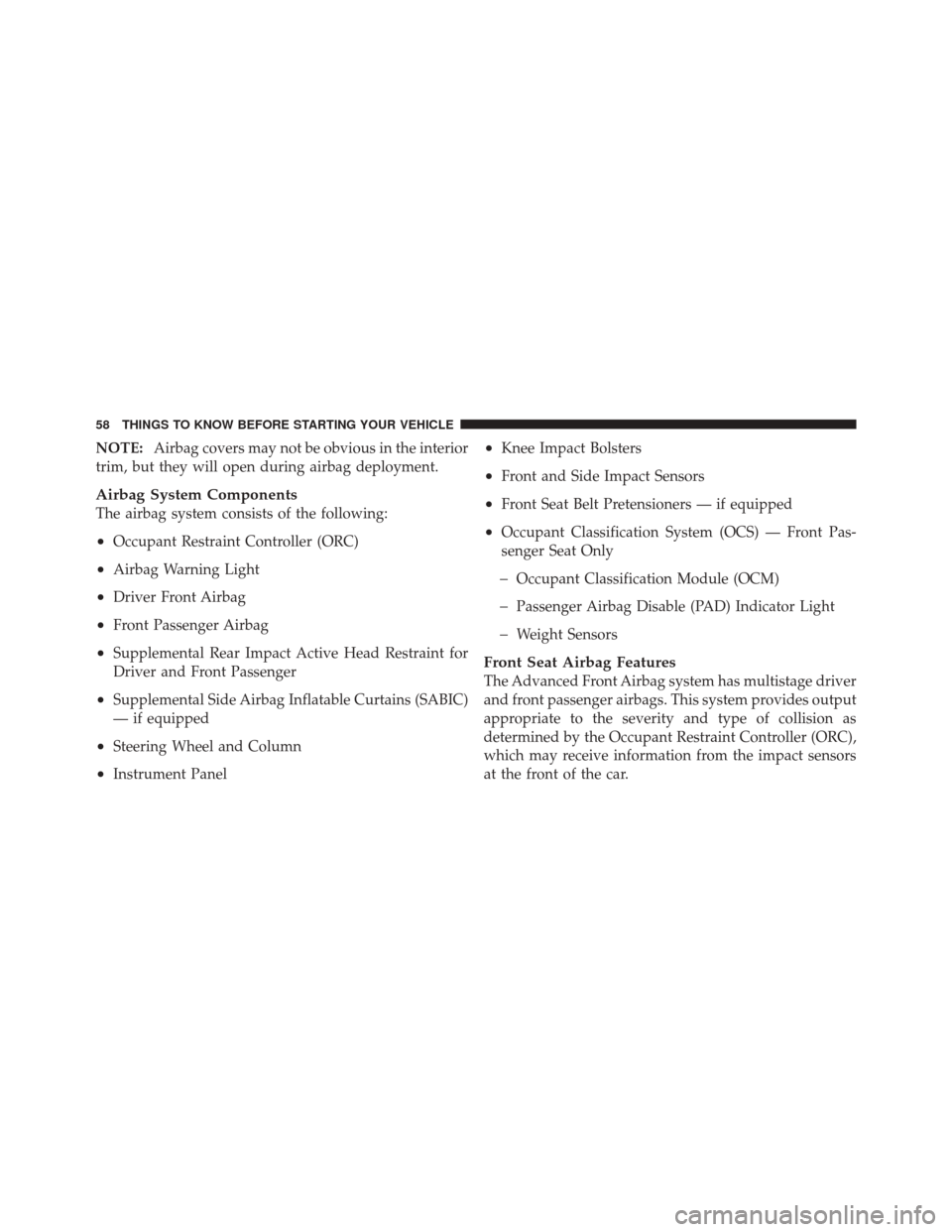
NOTE:Airbag covers may not be obvious in the interior
trim, but they will open during airbag deployment.
Airbag System Components
The airbag system consists of the following:
•Occupant Restraint Controller (ORC)
•Airbag Warning Light
•Driver Front Airbag
•Front Passenger Airbag
•Supplemental Rear Impact Active Head Restraint for
Driver and Front Passenger
•Supplemental Side Airbag Inflatable Curtains (SABIC)
— if equipped
•Steering Wheel and Column
•Instrument Panel
•Knee Impact Bolsters
•Front and Side Impact Sensors
•Front Seat Belt Pretensioners — if equipped
•Occupant Classification System (OCS) — Front Pas-
senger Seat Only
�Occupant Classification Module (OCM)
�Passenger Airbag Disable (PAD) Indicator Light
�Weight Sensors
Front Seat Airbag Features
The Advanced Front Airbag system has multistage driver
and front passenger airbags. This system provides output
appropriate to the severity and type of collision as
determined by the Occupant Restraint Controller (ORC),
which may receive information from the impact sensors
at the front of the car.
58 THINGS TO KNOW BEFORE STARTING YOUR VEHICLE
Page 67 of 522
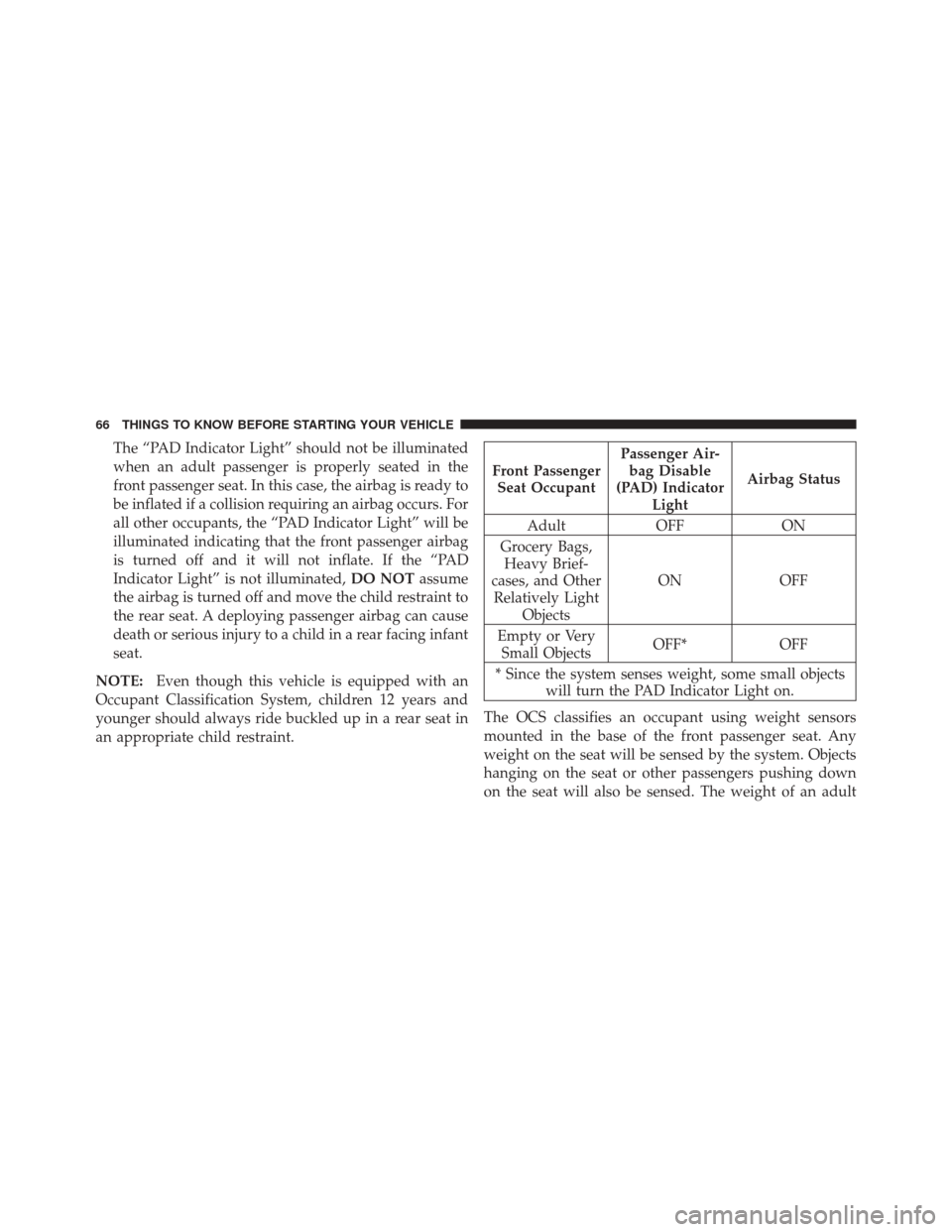
The “PAD Indicator Light” should not be illuminated
when an adult passenger is properly seated in the
front passenger seat. In this case, the airbag is ready to
be inflated if a collision requiring an airbag occurs. For
all other occupants, the “PAD Indicator Light” will be
illuminated indicating that the front passenger airbag
is turned off and it will not inflate. If the “PAD
Indicator Light” is not illuminated,DO NOTassume
the airbag is turned off and move the child restraint to
the rear seat. A deploying passenger airbag can cause
death or serious injury to a child in a rear facing infant
seat.
NOTE: Even though this vehicle is equipped with an
Occupant Classification System, children 12 years and
younger should always ride buckled up in a rear seat in
an appropriate child restraint.
Front Passenger Seat Occupant Passenger Air-
bag Disable
(PAD) Indicator Light Airbag Status
Adult OFFON
Grocery Bags, Heavy Brief-
cases, and Other Relatively Light Objects ON
OFF
Empty or Very Small Objects OFF*
OFF
* Since the system senses weight, some small objects will turn the PAD Indicator Light on.
The OCS classifies an occupant using weight sensors
mounted in the base of the front passenger seat. Any
weight on the seat will be sensed by the system. Objects
hanging on the seat or other passengers pushing down
on the seat will also be sensed. The weight of an adult
66 THINGS TO KNOW BEFORE STARTING YOUR VEHICLE
Page 68 of 522
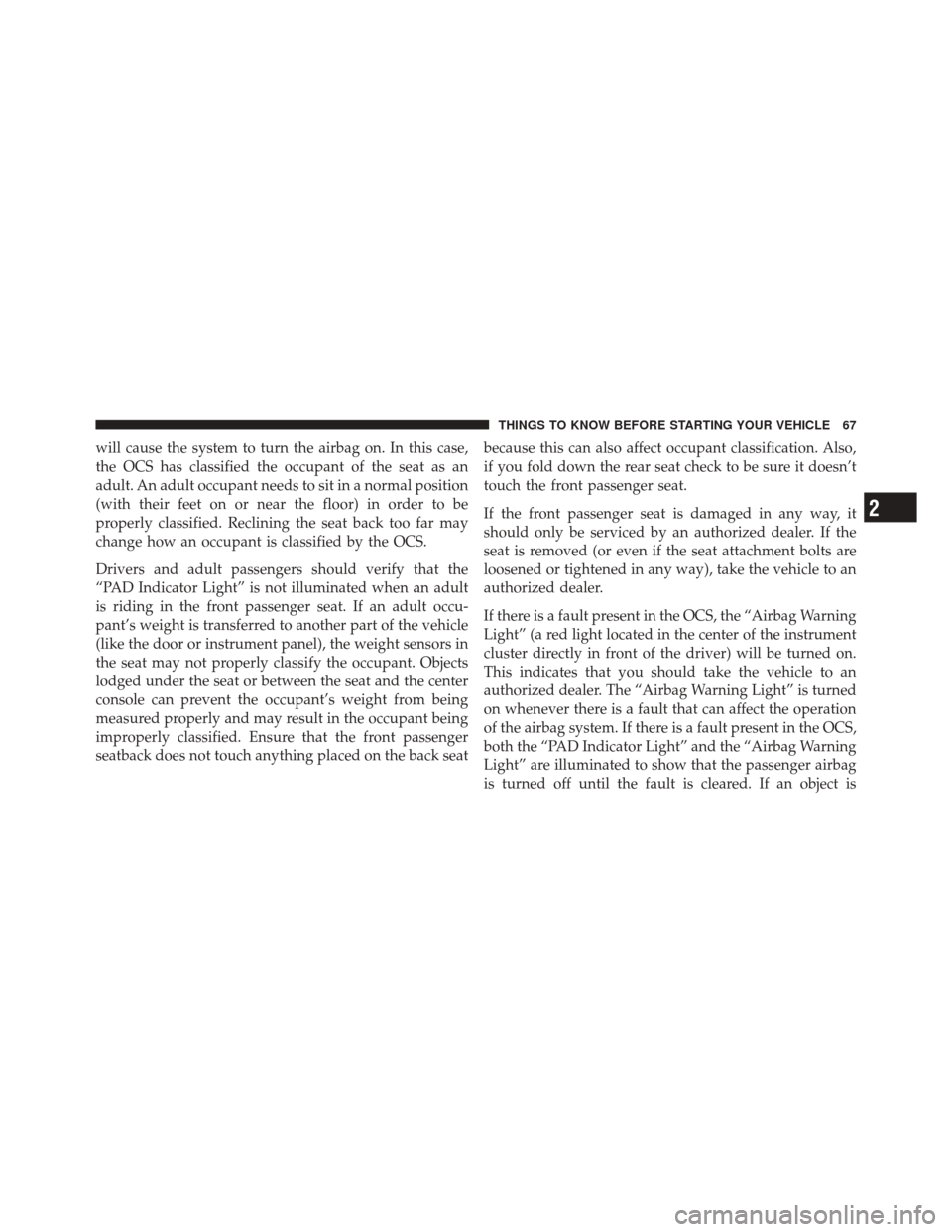
will cause the system to turn the airbag on. In this case,
the OCS has classified the occupant of the seat as an
adult. An adult occupant needs to sit in a normal position
(with their feet on or near the floor) in order to be
properly classified. Reclining the seat back too far may
change how an occupant is classified by the OCS.
Drivers and adult passengers should verify that the
“PAD Indicator Light” is not illuminated when an adult
is riding in the front passenger seat. If an adult occu-
pant’s weight is transferred to another part of the vehicle
(like the door or instrument panel), the weight sensors in
the seat may not properly classify the occupant. Objects
lodged under the seat or between the seat and the center
console can prevent the occupant’s weight from being
measured properly and may result in the occupant being
improperly classified. Ensure that the front passenger
seatback does not touch anything placed on the back seatbecause this can also affect occupant classification. Also,
if you fold down the rear seat check to be sure it doesn’t
touch the front passenger seat.
If the front passenger seat is damaged in any way, it
should only be serviced by an authorized dealer. If the
seat is removed (or even if the seat attachment bolts are
loosened or tightened in any way), take the vehicle to an
authorized dealer.
If there is a fault present in the OCS, the “Airbag Warning
Light” (a red light located in the center of the instrument
cluster directly in front of the driver) will be turned on.
This indicates that you should take the vehicle to an
authorized dealer. The “Airbag Warning Light” is turned
on whenever there is a fault that can affect the operation
of the airbag system. If there is a fault present in the OCS,
both the “PAD Indicator Light” and the “Airbag Warning
Light” are illuminated to show that the passenger airbag
is turned off until the fault is cleared. If an object is
2
THINGS TO KNOW BEFORE STARTING YOUR VEHICLE 67
Page 69 of 522
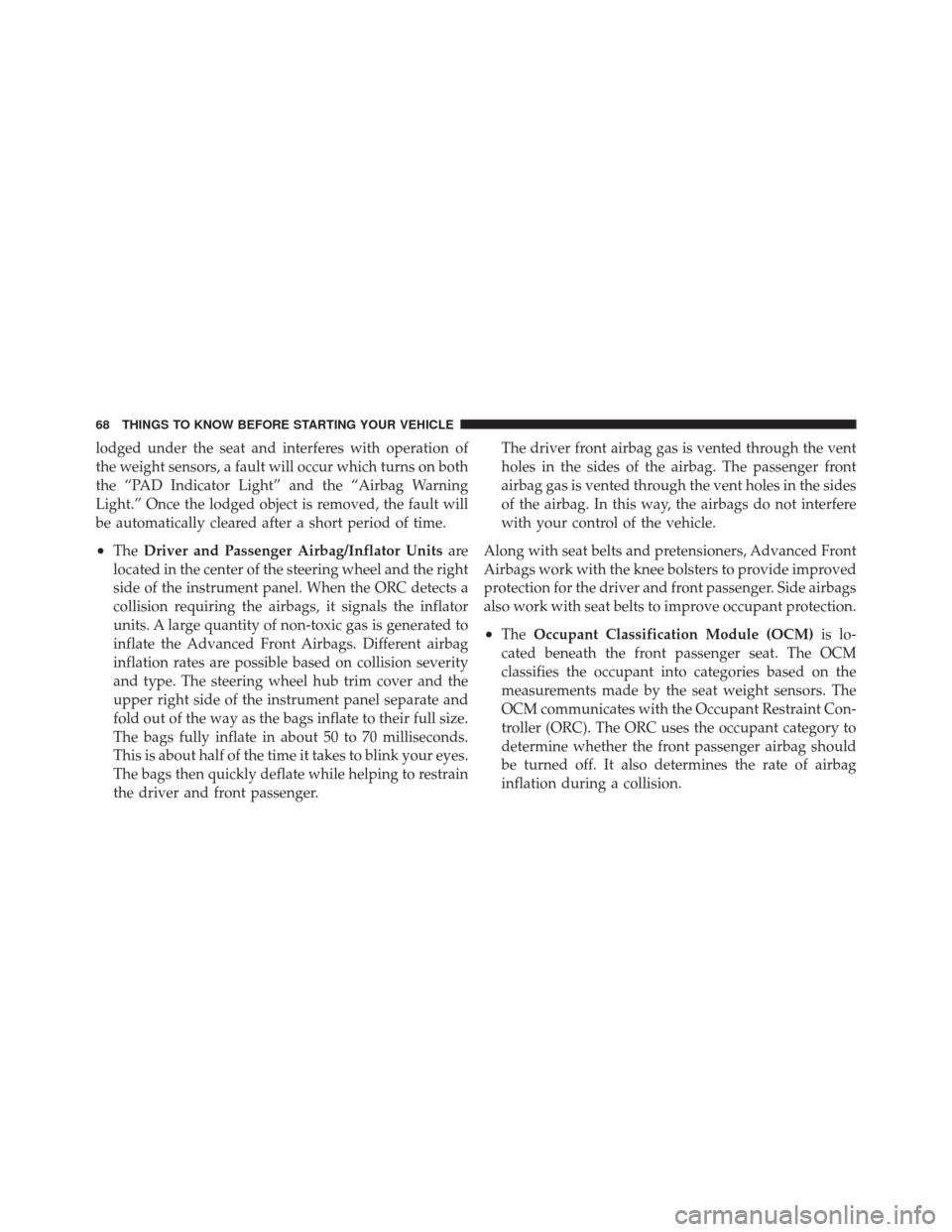
lodged under the seat and interferes with operation of
the weight sensors, a fault will occur which turns on both
the “PAD Indicator Light” and the “Airbag Warning
Light.” Once the lodged object is removed, the fault will
be automatically cleared after a short period of time.
•TheDriver and Passenger Airbag/Inflator Units are
located in the center of the steering wheel and the right
side of the instrument panel. When the ORC detects a
collision requiring the airbags, it signals the inflator
units. A large quantity of non-toxic gas is generated to
inflate the Advanced Front Airbags. Different airbag
inflation rates are possible based on collision severity
and type. The steering wheel hub trim cover and the
upper right side of the instrument panel separate and
fold out of the way as the bags inflate to their full size.
The bags fully inflate in about 50 to 70 milliseconds.
This is about half of the time it takes to blink your eyes.
The bags then quickly deflate while helping to restrain
the driver and front passenger. The driver front airbag gas is vented through the vent
holes in the sides of the airbag. The passenger front
airbag gas is vented through the vent holes in the sides
of the airbag. In this way, the airbags do not interfere
with your control of the vehicle.
Along with seat belts and pretensioners, Advanced Front
Airbags work with the knee bolsters to provide improved
protection for the driver and front passenger. Side airbags
also work with seat belts to improve occupant protection.
•The Occupant Classification Module (OCM) is lo-
cated beneath the front passenger seat. The OCM
classifies the occupant into categories based on the
measurements made by the seat weight sensors. The
OCM communicates with the Occupant Restraint Con-
troller (ORC). The ORC uses the occupant category to
determine whether the front passenger airbag should
be turned off. It also determines the rate of airbag
inflation during a collision.
68 THINGS TO KNOW BEFORE STARTING YOUR VEHICLE
Page 70 of 522
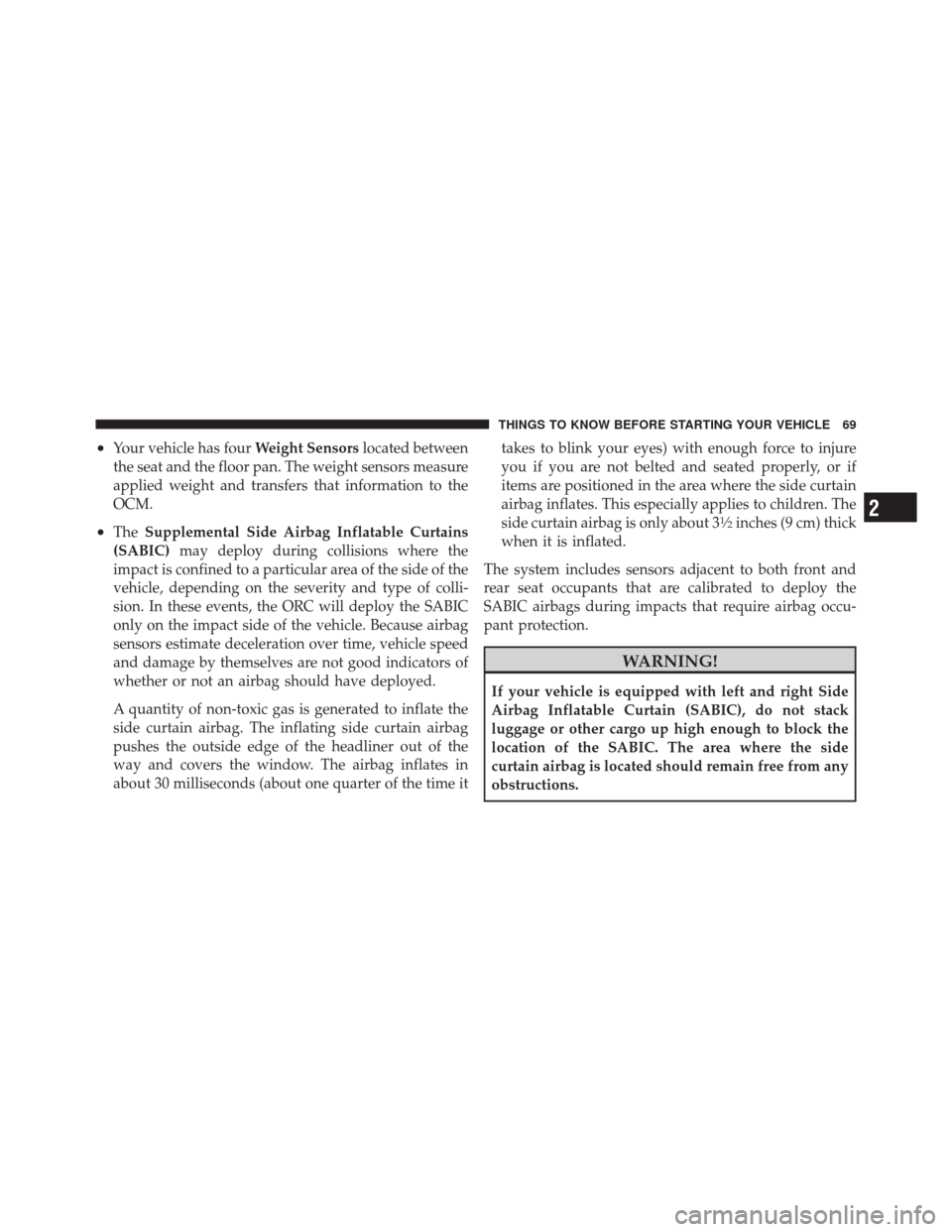
•Your vehicle has fourWeight Sensorslocated between
the seat and the floor pan. The weight sensors measure
applied weight and transfers that information to the
OCM.
•The Supplemental Side Airbag Inflatable Curtains
(SABIC) may deploy during collisions where the
impact is confined to a particular area of the side of the
vehicle, depending on the severity and type of colli-
sion. In these events, the ORC will deploy the SABIC
only on the impact side of the vehicle. Because airbag
sensors estimate deceleration over time, vehicle speed
and damage by themselves are not good indicators of
whether or not an airbag should have deployed.
A quantity of non-toxic gas is generated to inflate the
side curtain airbag. The inflating side curtain airbag
pushes the outside edge of the headliner out of the
way and covers the window. The airbag inflates in
about 30 milliseconds (about one quarter of the time it takes to blink your eyes) with enough force to injure
you if you are not belted and seated properly, or if
items are positioned in the area where the side curtain
airbag inflates. This especially applies to children. The
side curtain airbag is only about 31�2inches (9 cm) thick
when it is inflated.
The system includes sensors adjacent to both front and
rear seat occupants that are calibrated to deploy the
SABIC airbags during impacts that require airbag occu-
pant protection.
WARNING!
If your vehicle is equipped with left and right Side
Airbag Inflatable Curtain (SABIC), do not stack
luggage or other cargo up high enough to block the
location of the SABIC. The area where the side
curtain airbag is located should remain free from any
obstructions.
2
THINGS TO KNOW BEFORE STARTING YOUR VEHICLE 69
Page 77 of 522
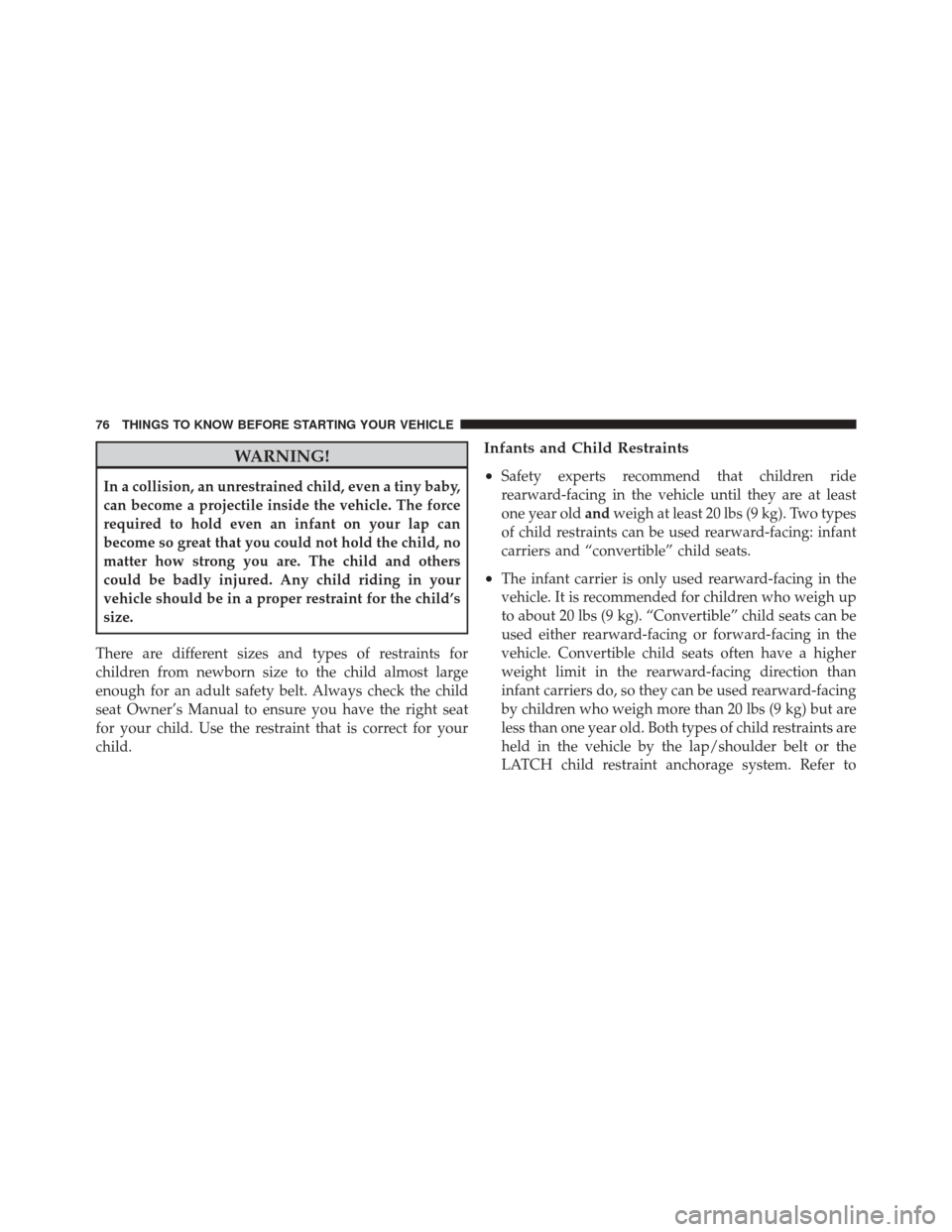
WARNING!
In a collision, an unrestrained child, even a tiny baby,
can become a projectile inside the vehicle. The force
required to hold even an infant on your lap can
become so great that you could not hold the child, no
matter how strong you are. The child and others
could be badly injured. Any child riding in your
vehicle should be in a proper restraint for the child’s
size.
There are different sizes and types of restraints for
children from newborn size to the child almost large
enough for an adult safety belt. Always check the child
seat Owner’s Manual to ensure you have the right seat
for your child. Use the restraint that is correct for your
child.
Infants and Child Restraints
•
Safety experts recommend that children ride
rearward-facing in the vehicle until they are at least
one year old andweigh at least 20 lbs (9 kg). Two types
of child restraints can be used rearward-facing: infant
carriers and “convertible” child seats.
•The infant carrier is only used rearward-facing in the
vehicle. It is recommended for children who weigh up
to about 20 lbs (9 kg). “Convertible” child seats can be
used either rearward-facing or forward-facing in the
vehicle. Convertible child seats often have a higher
weight limit in the rearward-facing direction than
infant carriers do, so they can be used rearward-facing
by children who weigh more than 20 lbs (9 kg) but are
less than one year old. Both types of child restraints are
held in the vehicle by the lap/shoulder belt or the
LATCH child restraint anchorage system. Refer to
76 THINGS TO KNOW BEFORE STARTING YOUR VEHICLE
Page 80 of 522
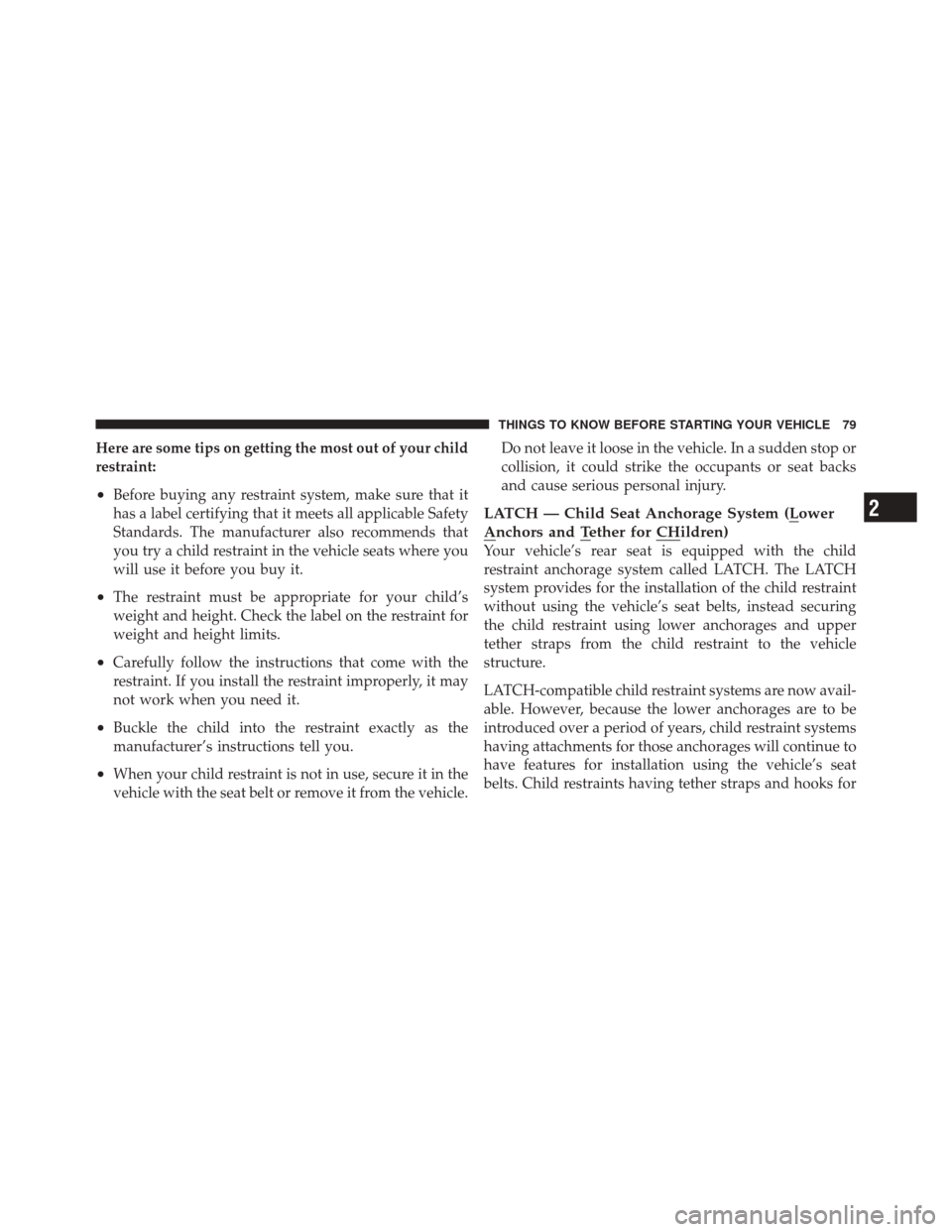
Here are some tips on getting the most out of your child
restraint:
•Before buying any restraint system, make sure that it
has a label certifying that it meets all applicable Safety
Standards. The manufacturer also recommends that
you try a child restraint in the vehicle seats where you
will use it before you buy it.
•The restraint must be appropriate for your child’s
weight and height. Check the label on the restraint for
weight and height limits.
•Carefully follow the instructions that come with the
restraint. If you install the restraint improperly, it may
not work when you need it.
•Buckle the child into the restraint exactly as the
manufacturer’s instructions tell you.
•When your child restraint is not in use, secure it in the
vehicle with the seat belt or remove it from the vehicle.Do not leave it loose in the vehicle. In a sudden stop or
collision, it could strike the occupants or seat backs
and cause serious personal injury.
LATCH — Child Seat Anchorage System (Lower
Anchors and Tether for CHildren)
Your vehicle’s rear seat is equipped with the child
restraint anchorage system called LATCH. The LATCH
system provides for the installation of the child restraint
without using the vehicle’s seat belts, instead securing
the child restraint using lower anchorages and upper
tether straps from the child restraint to the vehicle
structure.
LATCH-compatible child restraint systems are now avail-
able. However, because the lower anchorages are to be
introduced over a period of years, child restraint systems
having attachments for those anchorages will continue to
have features for installation using the vehicle’s seat
belts. Child restraints having tether straps and hooks for
2
THINGS TO KNOW BEFORE STARTING YOUR VEHICLE 79
Page 197 of 522
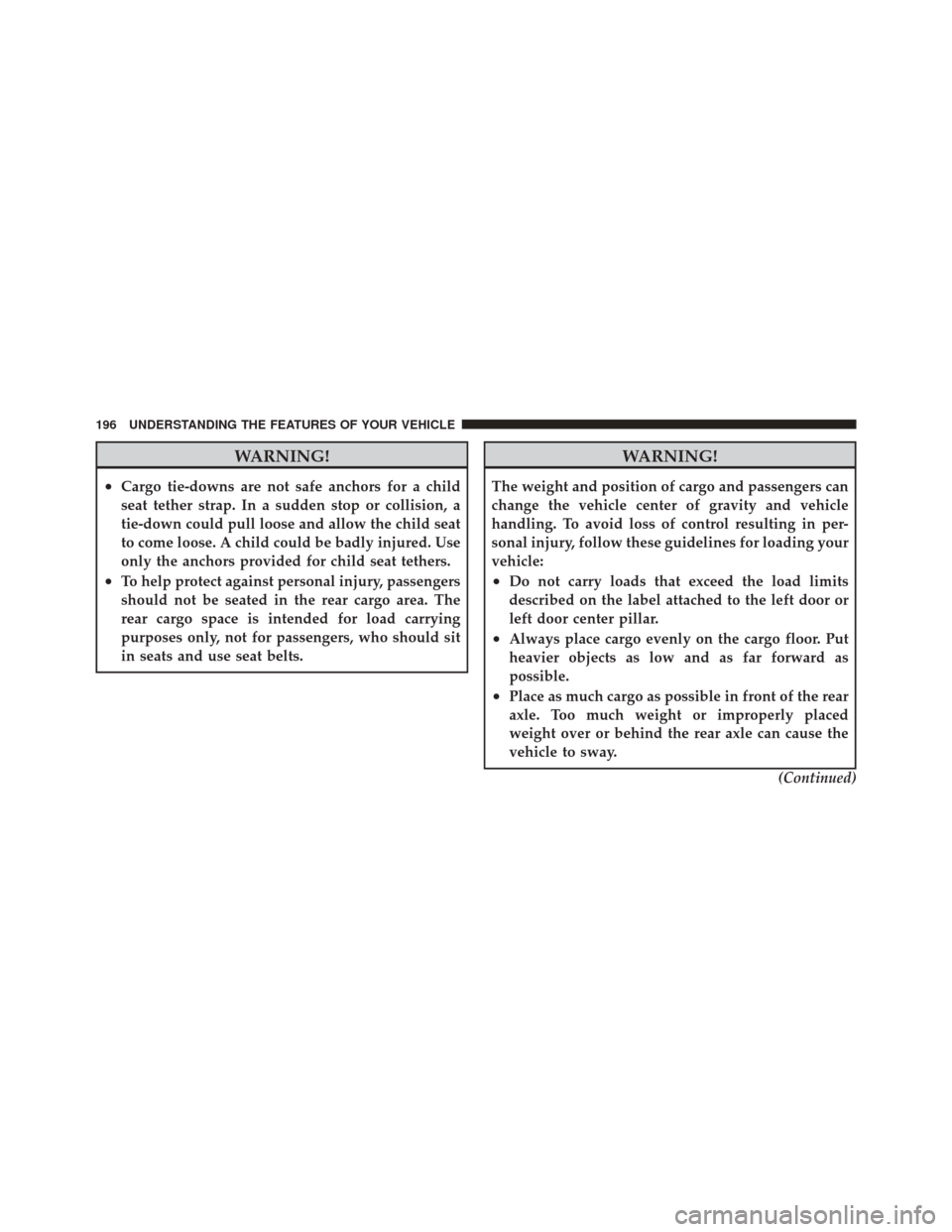
WARNING!
•Cargo tie-downs are not safe anchors for a child
seat tether strap. In a sudden stop or collision, a
tie-down could pull loose and allow the child seat
to come loose. A child could be badly injured. Use
only the anchors provided for child seat tethers.
•To help protect against personal injury, passengers
should not be seated in the rear cargo area. The
rear cargo space is intended for load carrying
purposes only, not for passengers, who should sit
in seats and use seat belts.
WARNING!
The weight and position of cargo and passengers can
change the vehicle center of gravity and vehicle
handling. To avoid loss of control resulting in per-
sonal injury, follow these guidelines for loading your
vehicle:
•Do not carry loads that exceed the load limits
described on the label attached to the left door or
left door center pillar.
•Always place cargo evenly on the cargo floor. Put
heavier objects as low and as far forward as
possible.
•Place as much cargo as possible in front of the rear
axle. Too much weight or improperly placed
weight over or behind the rear axle can cause the
vehicle to sway.(Continued)
196 UNDERSTANDING THE FEATURES OF YOUR VEHICLE